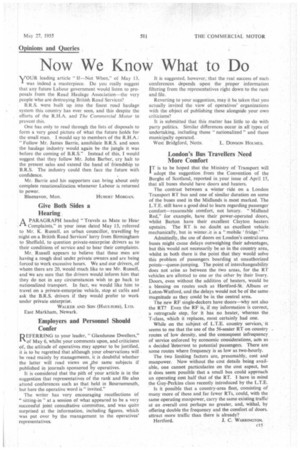London's Bus Travellers Need More Comfort
Page 55

If you've noticed an error in this article please click here to report it so we can fix it.
TT is to be hoped that the Ministry of Transport will A adopt the suggestion from the Convention of the Burghs of Scotland, reported in your issue of April 15, that all buses should have doors and heaters.
The contrast between a winter ride on a London Transport RT bus and one of similar duration on some of the buses used in the Midlands is most marked. The L.T.E. still have a good deal to learn regarding passenger comfort—reasonable comfort, not luxury. " Midland Red," for example, have their power-operated doors, whilst Barton have their excellent Clayton heaters upstairs. The RT is no doubt an excellent vehicle mechanically, but in winter-it is a "mobile ' fridge.' " Admittedly, the use of doors on London's central-area buses might cause delays outweighing their advantages, but this would not necessarily be so in. the country area, whilst in both there is the point that they would solve this problem of passengers boarding at unauthorized points—queue-jumping. The point of interchangeability does not arise as between the two areas, for the RT vehicles are allotted to one or the other by their livery. Doors, even without the addition of heaters, would be a blessing on routes such as Hertford-St. Albans or Luton-Watford, and the delays would not be of the same • magnitude as they could be in the central area.
The new RF single-deckers have doors—why not also the RT? Even the RF is, if my information is correct, a retrograde step, for it has no heater, whereas the T-class, which it replaces, most certainly had one.
While on the subject of L.T.E. country services,-it seems to me that the use of the 56-seater RT on country . routes of low density, and the consequent infrequency of service enforced by economic considerations, acts as a decided 'deterrent to potential passengers. There are some routes where frequency is as low as two-hourly.
The two limiting factors are, presumably, cost and manpower. Now without the cost details being available, one cannot particularize on the cost aspect, but it does seem possible that a small bus could approach an operating cost half that of the RT. I have in mind the Guy-Perkins class recently introduced by the LT.E.
Is it possible that a country-area fleet, consisting of many more of these and far fewer RTs, could, with the same operating manpower, carry the same existing traffic at an overall cost perhaps no greater, and, withal, by offering double the frequency and the comfort of doors. attract more traffic than there is already?
Hertford. J. C. WARRINGTON.








































































































